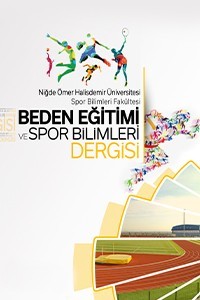SPORDA HEDEF BELİRLEMENİN PENALTI ATIŞLARI ÜZERİNE ETKİSİNİN ARAŞTIRILMASI
Hedef belirleme, penaltı atışı, futbol antrenmanları
THE EFFECT OF GOAL SETTING IN SPORTS ON PENALTY KICKS
Goal setting, penalty kick, football training,
___
- Atahan, A., Akalan, C. (2008). Zihinsel
- Antrenman ve Yüksek Performans. Spormetre Beden Eğitimi ve Spor Bilimleri Dergisiğ, 6 (1), 39- 43.
- Botwina, R., Krawczynski, M. (2003). “Application of visulation in training of young football players”, XI. European Congress of Sport Psychology.
- Botterill, C.B. (1977). “Goal setting and performance on an endurance task.” University of Alberta, unpublished doctoral dissertation.
- Burton, D. ve Naylor, S. (2002). The Jekyll/ Hyde nature of goals: Revisiting and updating goal- setting in sport. Advances in Sport Psychology. (Edt): Horn, T. S. (Second edition). Illinois: Human Kinetics Books. Sf. 459-496.
- Gill, D. (1986). Psychological Dynamics of Sport. Illinois: Human Kinetics Books
- Gould, D. (1993). Goal setting for pesk performance. In Willias, J. M. (Ed) Applied Sprot
- Psychology: Personal Growth to Peak
- Performance. pp 158-165.
- Konter, E. (2003). Spor Psikolojisi Uygulamalarında Yanılgılar ve Gerçekler, Dokuz Eylül Yayınları, s. 7, 31, 32, 37, Ankara.
- Koruç, Z. (1996). Sporda hedef belirleme ve hedef belirleme modelleri. Sporda Psiko-Sosyal Alanlar Seminer Kitabı. Ankara Üniversitesi, 7-8 Haziran, 63-79.
- Locke, E. A., Latham, G. P. (1985). The application of goal setting to sports. Journal of Sport
- Psychology, 7, 205-222.
- Locke, E. A. ve Latham, G. P. (1990). A Theory of Goal Setting and Task Performance. Englewood Cliffs, NJ: Prentice Hall.
- Locke, E.A. ; Shaw, K.N.: Saari, L.M.; Latham, G..P. (1981). Goal Setting and Task Performance: 1969-1980. Psychological Bulletin, 90, 125-152.
- Sosovec, L. G. (2004). “Internal visual imagery and its effect on penalty kicks in soccer”, Unpublished Doctoral Dissertation, South Dakota State University.
- Toros, T. (2001). Elit ve Elit Olmayan Erkek Basketbolcularda Hedef Yönelimi Güdüsel (Motivasyonel) İklim Hedeflerin Özgünlük ve Güçlük Derecesinin Yaşam Doyumuna Etkisi. (Yayınlanmamış Yüksek Lisans Tezi). Mersin: Mersin Üniversitesi, Sağlık Bilimleri Enstitüsü.
- Lerner, B. S. ve Locke, E. A. (1995). The effects of goal setting, self-eficacy, competition, and personal traits on the performance of an endurance task, Journal of Sport & Exersice Psychology, 17, 138-152.
- Weinberg, R.S.: Gould, D. (1995). Foundation of Sport and Exercise Psychology. Champaign, IL: Human Kinetics.
- ISSN: 1307-6477
- Yayın Aralığı: Yılda 3 Sayı
- Başlangıç: 2007
- Yayıncı: Niğde Ömer Halisdemir Üniversitesi
SPORDA HEDEF BELİRLEMENİN PENALTI ATIŞLARI ÜZERİNE ETKİSİNİN ARAŞTIRILMASI
Turhan TOROS, Mehmet BAYANSALDUZ, Ahmet DUVAN
ELİT MASTER ATLETLERİN VÜCUT KOMPOZİSYONU VE FİZİKSEL PERFORMANSLARININ CİNSİYETE GÖRE İNCELENMESİ
MAKSİMAL YÜKLENME YOĞUNLUĞUNUN ELİT TÜRK ESKRİMCİLERİN GÖRSEL REAKSİYON ZAMANLARI ÜZERİNE ETKİSİ
